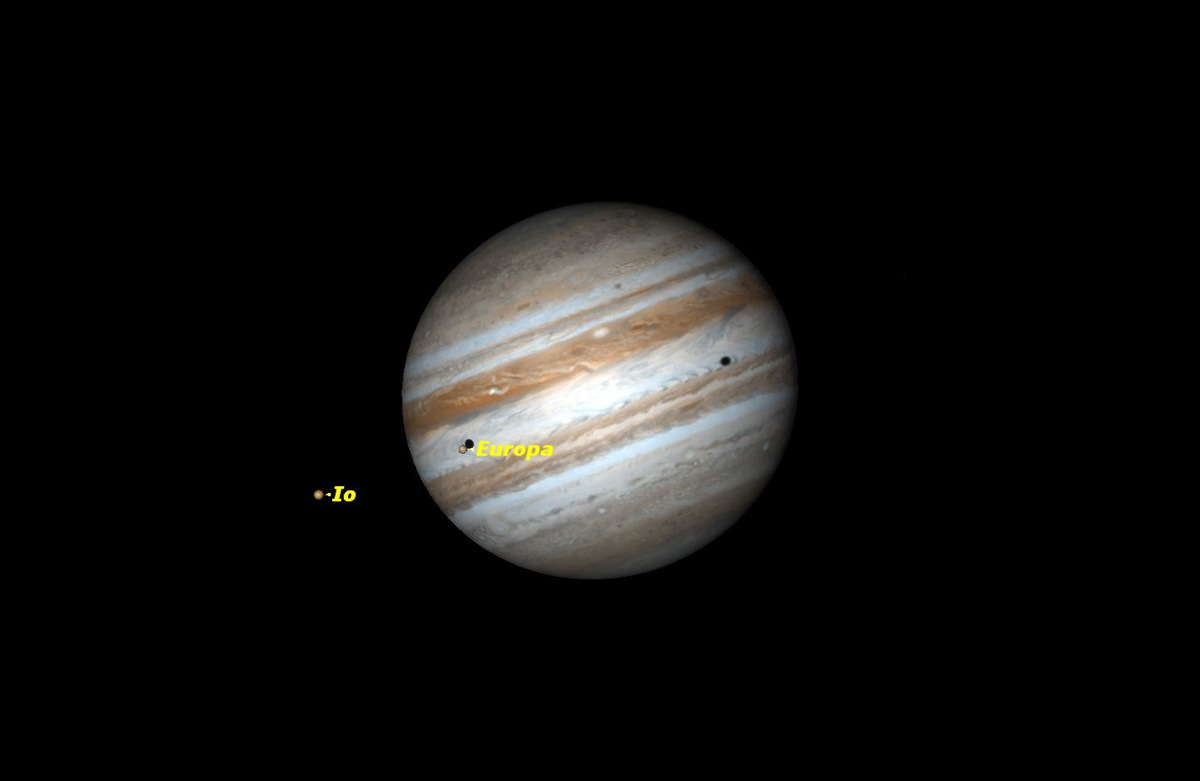Two Moons Cast Shadows on Jupiter Tonight: How to See It

Skywatchers with telescopes on Earth will be able to witness a remarkable cosmic event tonight (Dec. 15): Two of Jupiter's moons will cast shadows on the face of the gas giant in the same night.
As Jupiter's moons revolve around the gas giant, they regularly pass in front of the planet and cast shadows on its face. From time to time, the positions of the moons in orbit are such that two or three moons (and their shadows) can pass across Jupiter at the same time. Tonight, stargazers will have the chance to witness one of these double transits.
The shadows cast on Jupiter by the moons Io and Europa are very tiny. The transits will be visible only in telescopes with at least 90mm aperture magnifying at least 100 times. By the time Jupiter is high enough to observe, around 11 p.m. EST (0400 GMT), the show is about to begin. About 9 minutes after the planet rises, a tiny notch will appear on Jupiter's left limb, as the shadow of Europa begins across the huge planet's face. [Best Stargazing Events of December 2014 (Sky Maps)]
Although the moon will begin its transit on the left side of Jupiter when seen with the naked eye, Europa will actually look like it is starting its transit on the right side of the planet in most reflector telescopes and refractors and catadioptric telescopes with diagonals.
At 1:12 a.m. EST (0612 GMT), Io's shadow will follow Europa's onto Jupiter's face. Europa's shadow will be two-thirds of the way across Jupiter. A few minutes later, at 1:18, Europa itself can be seen crossing Jupiter, almost in front of Io's shadow. Although visible as a bright point of life for a few minutes, Europa soon blends into the background of Jupiter's clouds, visible only in very large telescopes.
At 2:02 a.m. EST, Europa's shadow passes off Jupiter, and at 2:15 a.m. EST, the moon Io itself begins across. But like Europa, it fades to invisibility a few minutes later.
At 3:29 a.m. EST (0829 GMT), Io's shadow leaves Jupiter's face. A few minutes before Europa's transit ends at 4:12 a.m. EST, the moon can be seen just inside Jupiter's limb. Finally, at 4:32, Io leaves Jupiter's face and the show is over.
Get the Space.com Newsletter
Breaking space news, the latest updates on rocket launches, skywatching events and more!
If you miss this event, don't be too disappointed, because this is only one of a series of double transits, leading up to a rare triple transit on the night of Jan. 24.
These transits are predicted years in advance, and the predictions can be found in the Observer's Handbook of the Royal Astronomical Society of Canada, in astronomy magazines and online. The transits are also depicted by astronomy software programs like Starry Night, but there is something special about observing them with your own eyes through a telescope.
Editor's Note: If you capture an amazing photo of the double transit or any other skywatching image you'd like to share for a possible story or image gallery, please contact managing editor Tariq Malik at spacephotos@space.com.
This article was provided to Space.com by Simulation Curriculum, the leader in space science curriculum solutions and the makers of Starry Night and SkySafari. Follow Starry Night on Twitter @StarryNightEdu. Follow us @Spacedotcom, Facebook and Google+. Original article on Space.com.
Join our Space Forums to keep talking space on the latest missions, night sky and more! And if you have a news tip, correction or comment, let us know at: community@space.com.

Geoff Gaherty was Space.com's Night Sky columnist and in partnership with Starry Night software and a dedicated amateur astronomer who sought to share the wonders of the night sky with the world. Based in Canada, Geoff studied mathematics and physics at McGill University and earned a Ph.D. in anthropology from the University of Toronto, all while pursuing a passion for the night sky and serving as an astronomy communicator. He credited a partial solar eclipse observed in 1946 (at age 5) and his 1957 sighting of the Comet Arend-Roland as a teenager for sparking his interest in amateur astronomy. In 2008, Geoff won the Chant Medal from the Royal Astronomical Society of Canada, an award given to a Canadian amateur astronomer in recognition of their lifetime achievements. Sadly, Geoff passed away July 7, 2016 due to complications from a kidney transplant, but his legacy continues at Starry Night.










